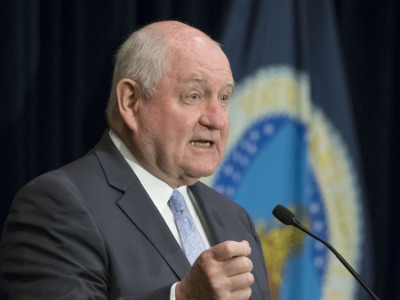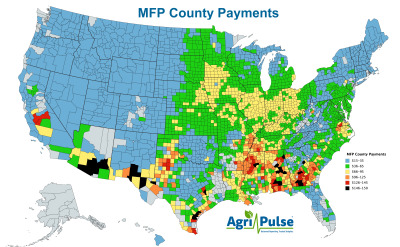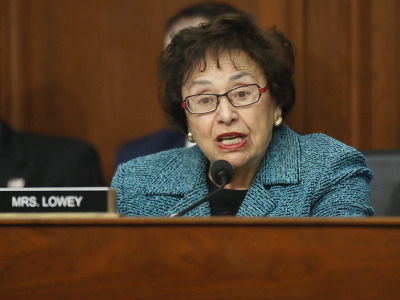In 2019, the attention of farm country was keenly focused on international trade developments, and the Trump administration’s efforts to lessen their blow on producers, according to an analysis of Agri-Pulse's website traffic throughout the year.
The Trump administration’s trade negotiations, congressional action on the U.S.-Mexico-Canada-Agreement, and implementation of the Market Facilitation Program were routinely among the top stories for any given month. In January, the government shutdown, and what the shutdown would do to MFP payments, also dominated attention.
Here’s a look at the top news stories for each month — lightly edited to avoid a few cases of duplication — based on Agri-Pulse web traffic analytics.
January
February SNAP benefits going out early due to shutdown
The year started with a partial government shutdown that lasted 35 days and ended Jan. 25. The shutdown left many parts of the federal government — including USDA — scrambling to meet the needs of citizens with limited staff and resources to do so. Thousands of people read stories like this, which detailed efforts to make sure recipients of Supplemental Nutrition Assistance Program funds would have access to their support in the event the shutdown continued to linger.
Also in the news:
USDA to open FSA offices temporarily: Ag Secretary Sonny Perdue opened about half the nation’s FSA offices to perform “certain limited services” during the shutdown.
Pelosi announces new appointments to House Agriculture Committee: The 2018 midterm elections put Democrats in control of the House of Representatives and brought a new slate of freshman members of the House Agriculture Committee along with it.
February
Big changes ahead in land ownership and farm operators?
This story kicked off our Farm and Food Policy Strategies for 2040 series, which focused on looming changes that will shape the future of American agriculture. In this particular piece, Sara Wyant and Ed Maixner focused on what land ownership trends industry experts saw on the horizon, including things like average ages of farmland owners inching higher and a greater quantity of non-farmer landowners.
Also in the news:
Where and how will farmers grow our food in 2040?: Another story in our 2040 series focused on the kinds of agricultural production that can be expected in the future and the changing geographies of where that might take place.
Plant-based, animal protein demand shows no sign of letting up: Alternatives to traditional protein have been in the news for a variety of reasons recently, but as this story explores, there’s plenty of demand for the traditional stuff, too.
March
Trump budget reopens farm bill to slash spending
President Donald Trump’s annual budget didn’t spare farm and nutrition programs from its conservative spending cuts. It also suggested tweaks to eligibility for commodity and nutrition programs and slashed spending across a variety of programs critical to food and ag policy. But, like the budgets that came before it and other budgets to come, it was considered dead on arrival to Capitol Hill.
Also in the news:
Customer demand revolutionizing the food supply chain: Another in our 2040 series, this story examined how consumer demand was shaping the actions of the food system from farm to table.
USDA, FDA finalize cultured meat regulatory agreement: USDA and FDA set the parameters for how the government would regulate cultured meat products in a deal that gave USDA oversight over harvesting and labeling of the products, which are not yet on the market.
April
Fewer farms, older farmers: USDA releases 2017 Ag Census
USDA’s treasure trove of agricultural data was released later than originally planned due to the January shutdown and a few other issues. But the figures showed what was already concerning many in farm country: farmers are getting older and fewer and farther between.
Also in the news:
NPPC cancels World Pork Expo over ASF concerns: Any question of whether or not the U.S. pork industry was taking the threat of African Swine Fever seriously was put to bed when the National Pork Producers Council canceled its signature summer event out of an “abundance of caution.”
Senate Ag launching child nutrition debate: The finalization of the 2018 farm bill cleared the way for another long-running effort for congressional ag leaders: the effort to secure long-term reauthorization of federal child nutrition programs.

Ag Secretary Sonny Perdue announced the 2019 round of MFP in May.
May
USDA unveils new trade aid for farmers, ranchers
Months of speculation about whether or not there would be another round of MFP came to a close on May 23, when USDA announced that it would have another $16 billion trade mitigation package. But details of how those funds would be distributed to the nation’s producers wouldn’t come until July as USDA said it didn’t want to influence decisions during an already sluggish planting season slowed by wet weather across the Corn Belt.
Also in the news:
Disaster aid deal covers prevented planting, stored crops: The struggles of spring planting were reflected in a disaster bill agreement that allowed for assistance to go to producers with unplanted acres.
FCA Chairman Dallas Tonsager, former USDA undersecretary, dies: Dallas Tonsager, a lifelong public servant who was most recently the chairman of the Farm Credit Administration, passed away in May after a battle with lymphoma at the age of 64.
June
Unplanted acres deemed ineligible for trade aid
The window of time between MFP announcement and USDA’s release of the program’s details left many wondering how the program would affect different aspects of production agriculture. Since the 2018 program relied upon actual production, many producers were worried the 2019 MFP would as well as they surveyed their land to see thousands of acres too wet to plant.
Also in the news:
Long-stalled disaster aid clears Congress: Congress passed a $19.1 disaster aid package, with $5.5 billion set aside for ag producers impacted by disasters in 2018 and 2019.
USDA pressed to ease cover crop rules as farmers struggle to plant: Federal rules governing planting deadlines for cover crops were under the microscope this year as wet conditions prevented normal planting practices.
July
USDA announces county rates for 2019 MFP payments
USDA rolled out its payment schedule for each county that was to receive MFP payments for their ag production under the 2019 edition of the program, kick-starting a debate about the merits of the department’s formula and complaints of favoritism tilted toward southern states. USDA has defended the program, saying it was a more comprehensive way to reflect the long-term impact of trade disruption and an area’s typical commodity mix.

Our look at MFP payment rates across the country.
Also in the news:
New trade aid: Where and what you farm matters: Agri-Pulse produced a map of the county MFP payment rates across the country, providing a visualization of how much money was headed where.
Farmers to get at least $15 an acre in first MFP check: This story recounted some of the first details we had on USDA’s new approach: three tranches of payments and a minimum of $15 per acre.
August
Perdue, Peterson seek to tamp down producer concerns
While this was actually the second-most read story of the month (July’s story on MFP details topped the charts for both months), it certainly had the attention of the country both inside and outside of ag circles. Several farmers stepped to the mic to sound off on ag policy concerns to House Agriculture Chairman Collin Peterson, D-Minn., and Agriculture Secretary Sonny Perdue, who delivered his now-infamous “whine cellar” joke to mixed reviews from the crowd.
Also in the news:
USDA trims corn, soybean acres off June estimates: The report heard ‘round the world sent shock waves through rural America as producers said USDA’s reduced expectations for planted acres still far exceeded what they anticipated to harvest.
US and Japan reach deal on ag trade: In what would turn out to be the first of several trade talks that came to some kind of a conclusion, the U.S. and Japan reached an agreement in principle on a trade deal that was heavily focused on U.S. ag goods.
September

House Appropriations Chairwoman Nita Lowey got the attention of farm country with a brief spat over the future of the CCC.
Key House Democrat threatens farmer trade aid payments
A brief spat over the future of MFP funds threw the program into question as the leader of the House Appropriations Committee focused her attention on the Commodity Credit Corp., the funding authority USDA was using to issue the payments. The concern was short-lived, but lead to some charged comments from House Agriculture Committee members during a hearing on an entirely separate subject.
Also in the news:
Japan to slash ag tariffs, implement new quotas under US trade deal: Details on the U.S.-Japan deal were slow to emerge, but ag interests liked what they saw once specifics were available.
Average farm organization CEO pay topping $500K: Our annual look at the compensation of the leaders of the nation’s farm organizations showed rising compensation amid a troubled farm economy.
October
US, China forge tentative deal with big ag trade promises
The first of two “phase one” agreements this year came in October as the U.S. and China announced a handshake deal that briefly cooled the trade war between the two countries. But the pact would prove to be short-lived as the two countries publicly disagreed over agreed-upon provisions, including amounts of ag purchases in the deal.
Also in the news:
ASA picks Seyfert to lead lobbying team: The American Soybean Association shook up its lobbying strategy this year, choosing Christy Seyfert to lead an in-house government affairs team.
USDA releases long-awaited hemp regulations: The 2018 farm bill cleared the way for production of industrial hemp, but USDA still had some work to do on the subject.
November
USDA plans to release more MFP funds soon
July’s MFP announcement cleared the path for the first round of payments, but the next two rounds were left in flux as USDA analyzed trade progress and whether or not more payments were needed. The second round of checks was announced in November, sending more money to producers in farm country hit by the trade war.
Also in the news:
Pelosi: USMCA vote could slip into 2020: Negotiations to get the U.S.-Mexico-Canada Agreement were on the mind of many throughout the year, and House Speaker Nancy Pelosi injected a dose of caution when she offered an updated timeline during one of her weekly press conferences.
USDA confirms approval of Chinese chicken: Trade talks between the two countries involved a variety of different factors, including the long-running dispute over poultry trade between the U.S. and China.
December
US: China agrees to $40-50 billion in annual ag purchases for two years
Earlier this month, the U.S. rolled out details of what it said China had agreed to in the “phase one” trade deal, including $40-50 billion in annual purchases of American ag goods for the next two years. In this story, we broke down what we learned from a briefing conducted by a senior administration official, even as we await the final text of the deal.
Also in the news:
Negotiators agree to revive, extend biodiesel tax credit: The inclusion of the biodiesel tax credit in a year-end spending bill ended years of uncertainty for producers of the biofuel.
Lawyer for Roundup plaintiffs charged with extortion: A Virginia attorney is facing allegations of blackmail for his work on Roundup litigation.
For more news, go to www.Agri-Pulse.com.


